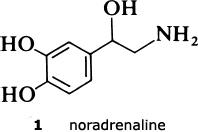5 Birth of a drug
5.1 The medical background
Blood pressure is normally tightly controlled in the face of large variations in blood flow required by activities such as vigorous exercise. The diameter of the blood vessels is under the influence of the so-called sympathetic nervous system. Impulses from the brain stimulate the release of a chemical substance, noradrenaline (1), from the nerve-endings close to the vessel walls. The noradrenaline then diffuses to the blood vessel wall, where it interacts with a specific molecular site called an alpha receptor. This interaction results in contraction of the smooth muscle in the vessel wall, and hence constriction of the blood vessel itself. Substances like noradrenaline that bring about biochemical and pharmacological changes are called agonists.

In hypertension, however, control is abnormal and blood pressure is raised. Although the primary cause is unknown, it is thought that the blood vessels become over-constricted, possibly through overactivity of the sympathetic nervous system, with release of greater than normal amounts of noradrenaline, thereby causing an increase in pressure for any given rate of flow.
About 10–20 per cent of the adult population in the UK suffers from hypertension, a condition that is a major contributor to heart disease. So the first criterion is met: there is a medical condition that needs to be treated. The very significant proportion of the population with hypertension also indicates a commercial opportunity for drugs which provide improvements over existing therapy, so fulfilling the second criterion.
